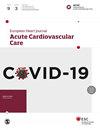Combining rivaroxaban with aspirin for peripheral artery disease: an in-depth systematic review and meta-analysis
IF 3.9
2区 医学
Q1 CARDIAC & CARDIOVASCULAR SYSTEMS
European Heart Journal: Acute Cardiovascular Care
Pub Date : 2024-05-09
DOI:10.1093/ehjacc/zuae036.017
引用次数: 0
Abstract
Funding Acknowledgements None. Introduction Peripheral artery disease (PAD) poses a significant challenge in the realm of cardiovascular medicine, necessitating a multifaceted approach to mitigate its impact and enhance patient outcomes. One treatment approach involves the combined use of rivaroxaban, a direct oral anticoagulant, and aspirin, a commonly used antiplatelet agent in decreasing possible complications that can develop in patients with PAD. Methods An extensive search of randomized controlled trials (RCTs) comparing the efficacy of rivaroxaban in combination with aspirin versus aspirin monotherapy among individuals diagnosed with peripheral artery disease. The assessment of this treatment approach involved evaluating the following primary outcomes: a decrease in major adverse cardiovascular events (MACE) and the need for major amputation. Safety profile was also evaluated by examining the rate of major bleeding, utilizing the scoring tool from International Society of Thrombosis and Hemostasis (ISTH). The analyses were performed using a random effects analysis approach via Review Manager V5.4. Results This meta-analysis encompassed three studies involving a total of 9,352 participants. There was reduction of MACE in rivaroxaban with aspirin therapy (RR 0.83 [95% CI: 0.71-0.97] I2 = 29%, p = 0.02] but there was no significant difference in terms of major amputation rates (RR 0.96 [95% CI: 0.80-1.14] I2 = 0%, p = 0.62). However, there was increased risk of bleeding in rivaroxaban with aspirin therapy (RR 1.46 [95% CI: 1.17-1.82] I2=0, p = 0.0009) compared to aspirin alone. Conclusion Rivaroxaban combined with aspirin therapy demonstrated a 17% reduction in MACE compared with aspirin monotherapy but didn’t reduce major amputation rates. Also, doing this strategy poses a higher risk of bleeding. Therefore, a balance between the risks and benefits of this combined therapy necessitates a thorough assessment of individual patient profiles, considering factors such as overall cardiovascular risk, comorbidities, and bleeding tendencies. Further research and long-term studies are needed to establish comprehensive guidelines for the appropriate utilization of this combination therapy in various patient populations.利伐沙班与阿司匹林联合治疗外周动脉疾病:深入的系统综述和荟萃分析
无。简介:外周动脉疾病(PAD)是心血管医学领域的一项重大挑战,需要采取多方面的方法来减轻其影响并提高患者的预后。一种治疗方法是联合使用利伐沙班(一种直接口服抗凝剂)和阿司匹林(一种常用的抗血小板药物),以减少 PAD 患者可能出现的并发症。方法 对随机对照试验(RCT)进行广泛检索,比较利伐沙班联合阿司匹林与阿司匹林单药治疗对外周动脉疾病患者的疗效。对这种治疗方法的评估包括以下主要结果:主要不良心血管事件(MACE)和主要截肢需求的减少。此外,还利用国际血栓与止血学会(ISTH)的评分工具,通过检查大出血率对安全性进行了评估。分析采用随机效应分析方法,通过审查管理器 V5.4 进行。结果 该荟萃分析包括三项研究,共有 9352 人参与。利伐沙班与阿司匹林治疗相比,MACE有所降低(RR 0.83 [95% CI: 0.71-0.97] I2 = 29%, p = 0.02),但在大截肢率方面没有显著差异(RR 0.96 [95% CI: 0.80-1.14] I2 = 0%, p = 0.62)。然而,与单独使用阿司匹林相比,利伐沙班联合阿司匹林治疗的出血风险增加(RR 1.46 [95% CI:1.17-1.82] I2=0,p = 0.0009)。结论 与阿司匹林单药治疗相比,利伐沙班联合阿司匹林治疗可将MACE降低17%,但并未降低主要截肢率。此外,采用这种策略会带来更高的出血风险。因此,要平衡这种联合疗法的风险和益处,就必须对患者的个体情况进行全面评估,考虑整体心血管风险、合并症和出血倾向等因素。还需要进一步的研究和长期研究,为在不同患者群体中适当使用这种联合疗法制定全面的指导原则。
本文章由计算机程序翻译,如有差异,请以英文原文为准。
求助全文
约1分钟内获得全文
求助全文
来源期刊

European Heart Journal: Acute Cardiovascular Care
Medicine-General Medicine
CiteScore
8.50
自引率
4.90%
发文量
325
期刊介绍:
The European Heart Journal - Acute Cardiovascular Care (EHJ-ACVC) offers a unique integrative approach by combining the expertise of the different sub specialties of cardiology, emergency and intensive care medicine in the management of patients with acute cardiovascular syndromes.
Reading through the journal, cardiologists and all other healthcare professionals can access continuous updates that may help them to improve the quality of care and the outcome for patients with acute cardiovascular diseases.
 求助内容:
求助内容: 应助结果提醒方式:
应助结果提醒方式:


